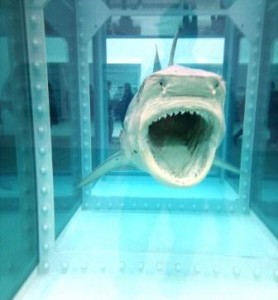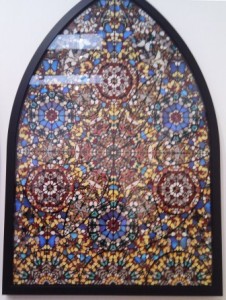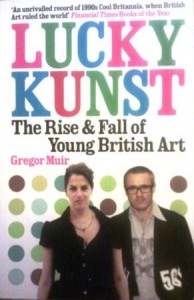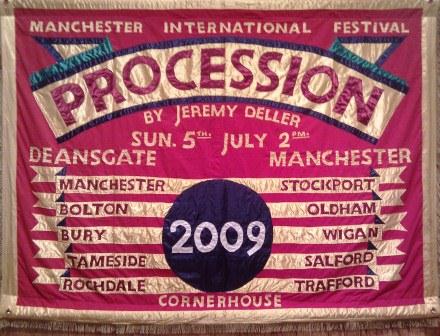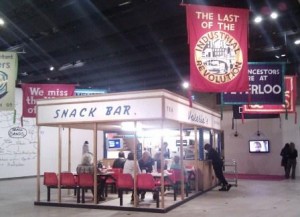One of the questions that recurs in my novel is the importance of location — especially for artists.In my novel Kim is a German artist who has arrived to London from Berlin in the expectation that it’s the place to be to make her name in the world of modern art. During the novel she also experiences the bucolic joys of the rural England that can still can be found, surprisingly, less than forty miles from grungy Shoreditch.
While it could be argued that Dalston, Stoke Newington, Hackney Wick or further flung places are where the artistic action is now happening, the spiritual homeland of contemporary urban art in London (if not the world) is still the Shoreditch/Hoxton/Brick Lane area. It’s been deserted by the Young British Artists (YBAs) of the late 90s (the group that included Tracey Emin and Damien Hirst and the subject of the interestingly titled Lucky Kunsts by Gregor Muir (although there’s a big Hirst formaldehyde thing apparently in the new Tramshed restaurant on Rivington Street). However, the place is becoming more corporatised with the arrival of the likes of Google in ‘Tech City’ at Old Street Roundabout — and endorsements by the likes of Boris Johnson and David Cameron.
As an aside, I met Mat Collishaw (apparently Emin’s ex) in person at a Love Art London event a few weeks ago at Blaine Southern in Hanover Square at his most recent exhibition — where his painting were going for £110,000 a piece.
Nevertheless, the locality still attracts the most infamous graffiti artists and is stuffed with galleries. I recently followed a walk from Hoxton Overground station via Shoreditch to Old Street in Stephen Millar’s London’s Hidden Walks 2 and found plenty of urban grittiness only a street or two away from where the hipsters hang out — at the top of Hoxton Street, for example.
The association of artists with the Shoreditch area suggests that location is an important factor for artists to attract attention from dealers, critics and buyers. It has a long historical precedent: some of the best known painters often made long journeys to their best markets. In Beak Street in Soho a plaque marks the location where Canaletto stayed for two years in the eighteenth century. He came to London to sell his pictures to patrons who liked reminders of the Grand Tour. Appropriately enough, the building now houses the Venetian-inspired restaurant, Polpo.
So having written about an artist who comes from Shoreditch and spends time in the Chilterns, I was fascinated to read a story on my local newspaper’s website about an artist who was was, in a way, doing the opposite.
Alexis Cole is an artist who works from home in Thame (which is a picturesque Oxfordshire market town with a huge main street with many good pubs about 45 miles out of London). Co-incidentally, like Kim, she comes from Europe — Croatia in Alexis’s case, although, when you meet her, it’s obvious she’s lived in this country for a while (she went to university here).
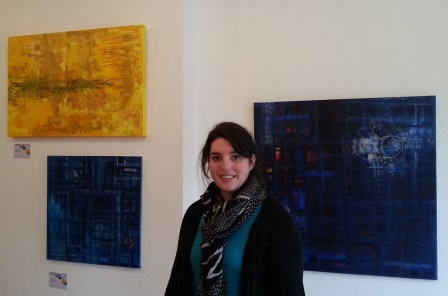
This was the first time Alexis had exhibited her work at a gallery and she chose to do so not in rural Thame but in the heart of the London contemporary art scene — at the Brick Lane Gallery Annexe (on Sclater Street, which connects Brick Lane with Shoreditch High Street Overground station). It’s a location that’s bang in the middle of the arty fringes of the City — close to Redchurch Street.
Alexis exhibited work in three broad genres: papier mache flowers (which were very popular); pastel pictures, generally of animals or geographical destinations; and abstract acrylic paintings that often had objects embedded in the surface. The last style reminded me of a cross between the abstract squares of colour of Mark Rothko and the collages of Kurt Schwitters — the German artist whose work can currently be seen in an an exhibition at Tate Britain (and mentioned previously in this blog post).
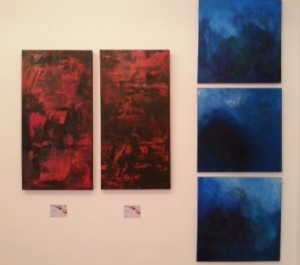
I got in touch with Alexis, explaining my interest, and visited her show, Transcendence, at the gallery the day after it opened in March. (It’s probably not giving away any spoilers about the novel to say that it wouldn’t be much of a story involving an artist if she didn’t put on any exhibitions.)
And I was impressed by Alexis’s artwork — as were other visitors. I’ve included a few photos of my favourite examples of Alexis’s artwork with this blog post, along with a photo of the artist herself, although as they were taken with a phone camera, they don’t do justice to the exhibition.
Alexis’s website (click here for the link) has much better photographs of the paintings and I’d recommend visiting it, although the three-dimensional works, like the collages and flowers need to be seen properly in person.
As this blog shows, I’ve tried to learn over the past couple of year more about how book publishing operates and I’m also interested how it compares with the market for art — an issue that’s close to the heart of my character, Kim.
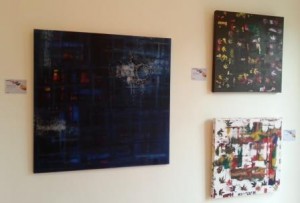
As far as I can tell, the art market appears to work in a less structured way because artworks are individual entities (or scarce copies in the case of numbered prints). This means they’re far more expensive to buy than books. For example the Battersea Affordable Art Fair which I attended recently with Love Art London defines ‘affordable’ as anything under £4,000.
By contrast, the written word is, in essence, intangible: like recorded music, once the work has been created it can be copied an infinite number of times. However, in the physical world, the fixed costs of printing a book are high. Aside from editing and marketing a book, publishers provide the large amounts of capital that funds book printing and distribution — a formidable barrier to entry for new writers.
On the other hand, an artist has to spend money on materials, whereas all a novelist needs is, arguably, paper and ink. (A Windows 95 spec computer with a prehistoric version of Word is good enough to write a manuscript — and, as for a fast internet connection, the likes of Twitter probably erodes any of potential productivity gain.)
Yet the artist creates an object that can immediately be sold (unless it’s performance or conceptual art) whereas the writer’s work results in a file on the computer or, without efficient printing technology, a heavy wad of A4 paper wrapped with an elastic band.
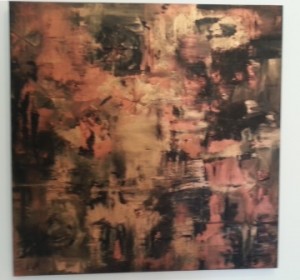
Given that, in all but the most extreme cases, a book takes longer to create than a piece of art, the writer needs to sell a substantial number of copies of a work just to cover the cost of its production (let alone make any income from the time spent writing it). Conversely an artist will sell a lesser number of works but they’ll usually be individually created (hence the controversy over the value of works that are very similar, like Damien Hirst’s spot paintings).
To market their work, an artist needs an exhibition space and then a means of attracting potential customers to it. Commercial galleries will often provide these functions in exchange for a substantial cut of the selling price of an artwork (many represent artists exclusively).
However, there are many other ways for artists to engage directly with their customers — it could be as simple as hiring a gallery space, hanging the art on the wall with a price tag and creating as much publicity as possible or maybe just hope for word of mouth to take off. There are also plenty of routes to market outside the traditional gallery channels for artists — for example, I know of a number of pubs that have dedicated art gallery spaces or are keen to showcase local artists’ work for sale.
No one opens a pop-up bookshop to sell their self-published novel — books have tended to be sold through a relatively limited number of outlets. Because of the small absolute profit made on books, they need to be sold in quantity — and in a place where they’re in competition with many other alternative titles.
Amazon is arguably even more dominant of the ebook market than Waterstones or the supermarkets are over the printed book. However, the marginal cost of reproducing ebooks is tiny and it is easy to list an ebook for sale on their site (albeit along with millions of anonymous titles) — and these factors may start to make the book market start to take on more similarities with the art market. For example, intermediaries (publishers, agents, booksellers) might be circumvented by those who can raise their visibility in the market by other means.
How artists measure their own success?
Certainly, as with writers, one substantial achievement would be to make a living from their artwork. Surprisingly few writers are able to survive on income from book royalties alone but there is a fairly well-defined progression of levels through which writers progress — a bit like a computer game. For example, being represented by an agent, getting a publishing deal are daunting hurdles to clear. And once published there are many stark metrics by which publishing is analysed — Nielsen Bookscan figures, Amazon ratings, etc.
It’s true that the art world has many prizes that are keenly contested, as does the literary world. However, there’s no equivalent of the Sunday Times Top Bestseller list for artists — which raises fundamental issues about how much of a commodity books are, as opposed to examples of creative art that can’t be ranked by sales figures.
Alexis was very happy with the exhibition — e-mailing me afterwards to say she was thrilled about how it had gone. She received some useful feedback from viewers of her work, sold several paintings and received some commissions. With a steady stream of inquisitive visitors to the gallery, the Brick Lane location seems to have worked well for Alexis.

